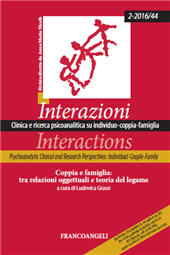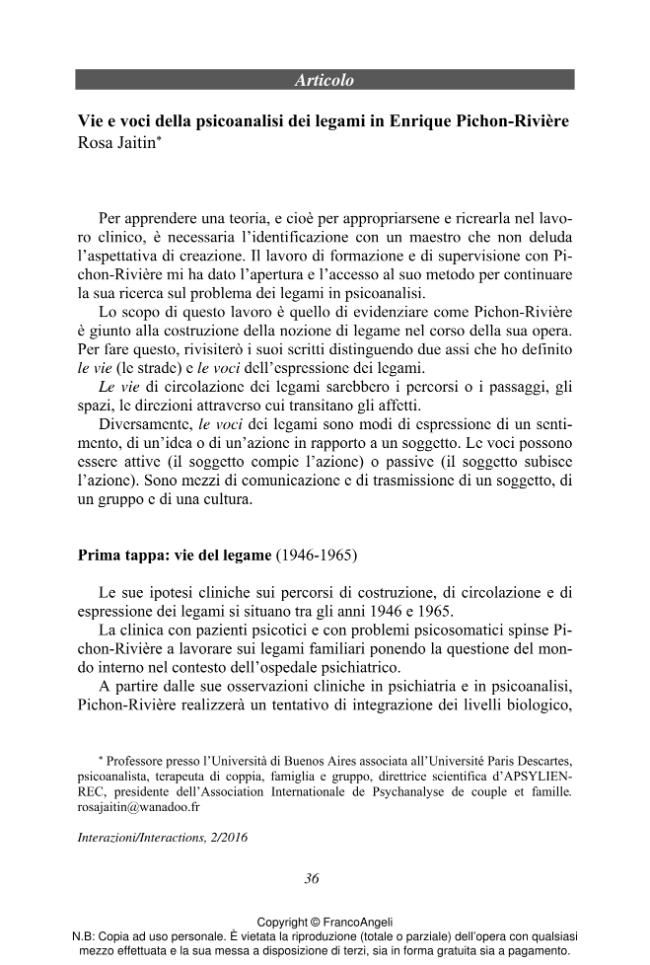Vie e voci della psicoanalisi dei legami in Enrique Pichon-Rivière
36-50 p.
Questo articolo ripercorre l'opera di Pichon-Riviér. Egli introdusse negli anni '50 l'ipotesi di un "legame come relazione a quattro vie" (di amore e di odio reciproci) tra il bambino e la madre. Il lavoro clinico sulle psicosi e sulle malattie psicosomatiche pose un interrogativo sulla condizione d'urgenza della malattia mentale, sulle sue aree di espressione, sul grado di simbolizzazione e sui diversi campi di osservazione clinica. A partire dagli anni '60, la clinica gruppale e familiare ha portato Pichon Rivière ad esplorare un secondo percorso diretto verso le voci del legame, quelle del sottogruppo interno-familiare e quelle delle voci sociali e culturali, in cui il legame si sviluppa. Fu allora che Pichon-Rivière definì il legame come "struttura bicorporale e trispersonale". In questo articolo, l'autore coniuga tutti i livelli di analisi del legame partendo da un lavoro psicoanalitico di coppia, di discendendi di seconda generazione di un genocidio che delimita il campo del legame transfero-controtran
sferale. Il linguaggio del corpo, nodo del legame transgenerazionale, le assenze/presenze alle sedute scandiscono un ritmo che conferisce l'illusione di una trasformazione del legame intersoggettivo tra i partner e con l'analista. [Testo dell'editore].
This article browses the work of Pichon Rivière. In the 50's he introduced the hypothesis of the "link as a four way relationship" (of mutual love and hatred between baby and mother). It is the clinic of psychosis and of psychosomatic disease that questioned him on the urgent conditions of the mental disease; its areas of expression; the degree of symbolization and various fields of clinical observation. As from the 60's, groupal and family clinic lead him to explore a second path directed towards the voices of the link, which of the internal family sub group, and the one of social and cultural voice, where the link develops. Then he defined the link as "bi corporeal and three-personal structure". Author puts together all the analysis levels of the link from a psychoanalytic process of the couple, of the second generation descendants of a genocide, which delimits the field of the transference and countertransference link. Body language, knot of the transgenerational link, absences and presences to the session
s mark a pace where appears the illusion which will transform the intersubjective link between the partners and with the analyst. [Publisher's Text].
Fa parte di
Interazioni : clinica e ricerca psicoanalitica su individuo-coppia-famiglia : 44, 2, 2016-
Articoli dello stesso fascicolo (disponibili singolarmente)
-
Informazioni
Codice DOI: 10.3280/INT2016-002005
ISSN: 2239-4389
PAROLE CHIAVE
- Enrique Pichon-Rivière, legami inconsci, vie e voci del legame, legame bicorporale-tripersonale, terapia psicoanalitica di coppia
- Enrique Pichon-Rivière, unconscious links, voices and ways of the link, bi-corporeal-three-personal link, psychoanalytic couple therapy



